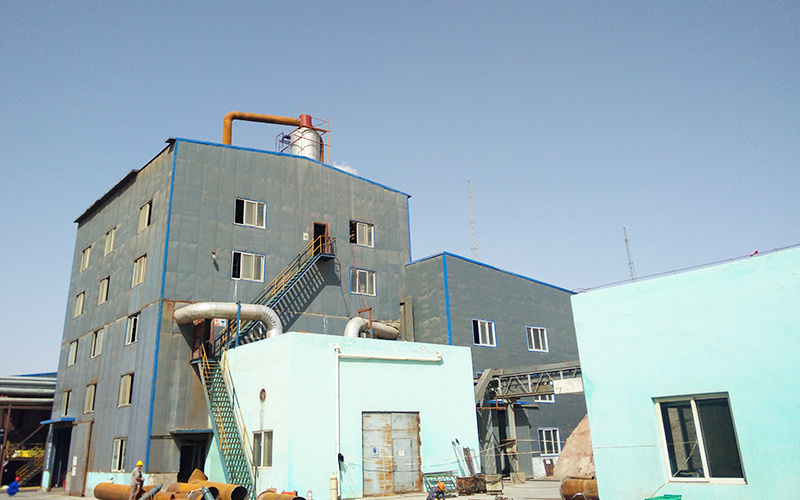Efficient Catalytic Oxidation Technology
Key words: Multi-effect evaporation | distillation | resin adsorption
Classification:
Product Description
Device Introduction
Currently, there are not many feasible technologies for deep sewage treatment processes: activated carbon adsorption, other chemical adsorbents, Fenton's method belongs to advanced oxidation, membrane methods, and aerated biological filters, etc. Although each has its advantages, they also have certain limitations. In comparison, our company has innovated the production of a new type of high-efficiency catalytic oxidation equipment, which has a high COD removal rate, small footprint, and high degree of automation.
In principle, this new type of high-efficiency catalytic oxidation process is the same as the Fenton process for oxidizing organic matter, both relying on •OH. However, the pathways for generating •OH are different. The Fenton process relies on Fe2+ to catalyze H2O2 under acidic conditions, which is a homogeneous catalysis. It not only requires the addition of chemical agents but also produces a large amount of iron sludge and sulfate after neutralization. In contrast, this equipment relies on "transition metal compounds," where the catalyst is in solid phase, representing heterogeneous catalysis, a true catalyst; when hydrogen peroxide is used as an oxidant, the reaction pH is controlled at 4-6; when ozone is used as an oxidant, the reaction pH is controlled to be neutral to slightly alkaline, producing no sludge, no salts, with high reaction efficiency, low dosage, and stable operation.
| Comparison Items | Traditional Fenton Process | New Catalyst Process |
| Method Principle | Adding ferrous ions and hydrogen peroxide for reaction | Catalytic generation of OH˙ to induce oxidant reaction |
| COD Removal Efficiency | Medium to low concentration: about 50%; High concentration: not applicable | Medium to low concentration: 70-80% High concentration: 80-95% |
| Reagent Usage | Ferrous, hydrogen peroxide, hydrochloric acid (Example: cost per ton of water 24.6 yuan) | Hydrogen peroxide/ozone (small amount, 1/3) (Example: cost per ton of water 5.5 yuan) |
| Secondary Pollution | Produces iron sludge residue, for solid/hazardous waste treatment; (Example: cost per ton of water 65-80 yuan) | Almost no secondary pollution (Example: cost per ton of water 9.8 yuan) |
| pH Range | Less than 4 | 4-9 wide range |
| Reaction Time | 120-240 min | 15-60 min |
| On-site Operation | Workers add chemicals, high labor intensity for sludge removal | Easy to operate, high degree of automation; easy to retrofit |
| Application Sections | Oxidation Pretreatment | Oxidation pretreatment, deep treatment, concentrate treatment, etc. |
Process Introduction
The new high-efficiency catalytic oxidant uses high-strength activated carbon as a carrier, loaded with various transition metals, rare earth elements, and their oxides, through high-temperature sintering, possessing stable pore structure, large specific surface area, uniform particle size, good wear and scouring resistance, high mechanical strength, and the active substances loaded on the carrier are not easy to fall off, with good adhesion and not prone to pulverization.
Performance Characteristics
1. Good framework
Appropriate density, easy to load and unload
2. Large specific surface area
Large specific surface area, high utilization rate of active substances, high reaction efficiency
3. Good adaptability to working conditions
High strength, not broken, not pulverized, not blocked, corrosion-resistant oxidation
4. High comprehensive cost performance
High reaction efficiency, low dosage, stable operation
The principle of the new high-efficiency catalytic oxidation device is to utilize the strong oxidant hydrogen peroxide under the conditions of the high-efficiency activated carbon catalyst to catalytically oxidize organic pollutants in wastewater at normal temperature and pressure, oxidizing large molecular organic pollutants into water and carbon dioxide, improving the biodegradability of wastewater, and effectively removing organic pollutants. The specific degradation process is as follows: organic pollutants containing azo groups, nitro groups, sulfide groups, carbamoyl groups, etc., in wastewater are acted upon by strong oxidants, breaking the double bonds in organic molecules, thus achieving the purpose of decolorization, while effectively increasing the BOD/COD ratio and improving the biodegradability of wastewater. In this way, the new high-efficiency catalytic oxidation device acts as a bridge between conventional physical-chemical pretreatment and biochemical treatment in high concentration, high toxicity, and high salt wastewater.

Related process
Online message
If you have any need, please feel free to contact us.
Phone:+86-15995082506(WeChat with the same number)
E-mail:jsyjhb001@163.com
Address: No.61, Lvshu East Road, Changzhou City, Jiangsu Province

Concerned about the public.
Copyright©2024 Jiangsu Yijian Environmental Protection Technology Co., Ltd.

